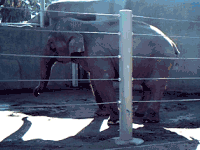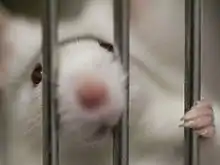Stereotypy (non-human)
In animal behaviour, stereotypy, stereotypical or stereotyped behaviour has several meanings, leading to ambiguity in the scientific literature.[1] A stereotypy is a term for a group of phenotypic behaviours that are repetitive, morphologically identical and which possess no obvious goal or function.[2] These behaviours have been defined as ‘abnormal’ as they exhibit themselves solely to animals subjected to barren environments, scheduled or restricted feedings, social deprivation and other cases of frustration,[3] but do not arise in ‘normal’ animals in their natural environments.[4] These behaviours may be maladaptive, involving self-injury or reduced reproductive success, and in laboratory animals can confound behavioural research.[5] Stereotypical behaviours are thought to be caused ultimately by artificial environments that do not allow animals to satisfy their normal behavioural needs. Rather than refer to the behaviour as abnormal, it has been suggested that it be described as "behaviour indicative of an abnormal environment."[6]

Stereotyped behaviour can also refer to normal behaviours that show low variation. For example, mammalian chewing cycles or fish capturing prey using suction feeding. Highly stereotyped movements may be due to mechanical constraint (such as the skull of a viper or fish, in which bones are mechanically linked), tight neural control (as in mammalian chewing), or both. The degree of stereotyping may vary markedly between closely related species engaging in the same behaviour.[1]
Onset and persistence

The display of stereotypies is usually increased in an individual over time due to the changing motivation of the stereotypy. The establishment of a stereotypy may be due to a number of factors within a captive environment. One of the factors within a captive environment that may affect the establishment of stereotypies is exploratory behaviours that are directed to the outside of a cage. Research suggests that some common stereotypic behaviours seen in mice, wire-gnawing for example, may originate from such exploratory behaviours. It has been noted that when mice climb on the bars of the cage, they frequently attempt to sniff outside the cage by putting their nose between the bars of the cage. During this process, mice will occasionally bite the bars. Over time, the frequency of biting the bar increases while the frequency of sniffing decreases until the mice are left with only the wire-gnawing stereotypy. Although there is strong evidence to suggest that the development of stereotypies is influenced by exploratory behaviours, the mechanisms behind these exploratory behaviours are still unclear. They may be the result of some attractive stimuli outside of the cage or they may result from a motivation to escape the cage.[7]
The continuance of a stereotypic behaviour can be explained by its impact on the basal ganglia [8] and the establishment of a habit in its expression. Research in humans suggests that damage to the dorsal basal ganglia can make it very difficult for a person to switch between two motor behaviours, thus they will continuously perform the same behaviour.[8] Similar difficulties in switching between motor behaviours have been seen in bank voles which suggests that basal ganglia dysfunction might be a factor in the development of stereotypies in rodents and other animals.[5]
The interruption or cease of a habit is much more tedious and difficult than that of the initial behaviour.[2] As stereotypies develop, they become more readily elicited, so much so that they are no longer just expressed during the original circumstances and may be expressed in the absence of any apparent stress or conflict. The development of the stereotypy into a habit and the difficulty of interrupting said habit explain why it is expected that the frequency of stereotypies increases with age.[2] There is also some research that suggests that the persistence of stereotypies might be due to behavioural differences between animals with stereotypies and those without. One of the behavioural differences that has been researched is a higher resistance to extinction seen in animals that exhibit stereotypic behaviours. Resistance to extinction occurs when animals are unable to stop a learned response. Research with domesticated dogs has shown that dogs who exhibit common stereotypic behaviours have higher resistance to extinction in a simple experimental task than other dogs. This correlation suggests that stereotypic behaviours in dogs may have been reinforced in some way early in their development and have persisted because these dogs are highly resistant to extinction.[9]
Examples
Many stereotypies can be induced by confinement; for example, cats pace in zoo cages.[11] Pregnant sows whose feed is restricted bite at their stalls' bars and chew without anything in their mouths.[12] In laboratory rats and mice, grooming is the most common activity other than sleep, and grooming stereotypies have been used to investigate several animal models of anxiety and depression.[13]
Examples of stereotypical behaviours include pacing, rocking, swimming in circles, excessive sleeping, self-mutilation (including feather picking and excessive grooming), and mouthing cage bars.
Stereotypies are seen in many species, including primates, birds, and carnivores. Up to 54% of elephants in zoos display stereotypical behaviors.[14][15] Stereotypic behaviour is also common in captive giraffes; although they perform a wide range of stereotypies, they predominantly lick inanimate objects, which may be related to limitations on natural foraging and feeding behaviour.[16][17] Stereotypies are well known in stabled horses, usually developing as a result of being confined, particularly with insufficient exercise. They are colloquially called stable vices. They present a management issue, not only leading to facility damage from chewing, kicking, and repetitive motion, but also lead to health consequences for the animal if not addressed.[18]
Asiatic black bears and Malayan sun bears also exhibit stereotypies when they are caged. Common stereotypies in these species include head throwing and jaw clamping.[19]
Stereotypies can also be seen in dogs. Common stereotypic behaviours in dogs include circling, light fixation and fly snapping.[9]
Solutions
Stereotypical behaviour can sometimes be reduced or eliminated by environmental enrichment, including larger and more stimulating enclosures, training, and introductions of stimuli (such as objects, sounds, or scents) to the animal's environment. The enrichment must be varied to remain effective for any length of time. Housing social animals such as primates with other members of their species is also helpful. However, once the behaviour is established, it is sometimes impossible to eliminate due to alterations in the brain.[6]
Animal welfare
The development and continued expression of stereotypies in captive animals can quickly become an animal welfare concern.[20] Stereotypies are considered one of the most important indicators of long-term animal welfare problems. A prolonged display of stereotypies suggests that the welfare of the animal is in a peril state.[4] The welfare of the mink is considered an important aspect from a management standpoint as it has repercussions on the production of the animal. Inadequate welfare has been linked to poor reproductivity and poor growth rate.[5]
Animal research
Extreme displays of stereotypies can be an animal welfare issue as well as a confound in behavioural research.[21] Since much of the behavioural research done on animals requires the subject to have a certain level of normal behavioural functioning, any stereotypic behaviour exhibited by the subjects could compromise the results.[22] However, expressions of stereotypic behaviour can also present a unique opportunity for researchers. Just as human research into basal ganglia dysfunction provided insight into the development of stereotypies in animals,[8] animal research on stereotypic behaviours may help understand the neuronal mechanisms behind many of the motor stereotypies seen in human clinical populations.[23]
See also
References
- "Home | Clemson University, South Carolina" (PDF).
- Mason, G. (1993). "Age and context affect the stereotypies of caged mink" (PDF). Behaviour. 127 (2): 191–229. doi:10.1163/156853993x00029. hdl:10214/4679.
- Hansen, S.; Jeppesen, L. (2006). "Temperament, stereotypies and anticipatory behaviour as measures of welfare in mink". Applied Animal Science Behaviour. 99 (1): 172–182. doi:10.1016/j.applanim.2005.10.005.
- Jeppesen, L.; Heller, K.; Bidsoe, M. (2004). "Stereotypies in female farm mink may be genetically transmitted with higher fertility due to effects on body weight". Applied Animal Behaviour. 86 (1): 137–143. doi:10.1016/j.applanim.2003.11.011.
- Evidence for a relationship between cage stereotypies and behavioural disinhibition in laboratory rodents. Behav Brain Res. 2002;136(1):83–92. doi:10.1016/S0166-4328(02)00111-0. PMID 12385793.
- Würbel, Hanno; Stauffacher, Markus; von Holst, Dietrich (1996-01-12). "Stereotypies in Laboratory Mice — Quantitative and Qualitative Description of the Ontogeny of 'Wire-gnawing' and 'Jumping' in Zur:ICR and Zur:ICR nu". Ethology. 102 (3): 371–385. doi:10.1111/j.1439-0310.1996.tb01133.x. ISSN 1439-0310.
- Luria, A. R. (March 1965). "Two Kinds of Motor Perseveration in Massive Injury of the Frontal Lobes". Brain. 88 (1): 1–10. doi:10.1093/brain/88.1.1. ISSN 0006-8950. PMID 14280275.
- Protopopova, Alexandra; Hall, Nathaniel J.; Wynne, Clive D.L. (2014). "Association between increased behavioral persistence and stereotypy in the pet dog". Behavioural Processes. 106: 77–81. doi:10.1016/j.beproc.2014.04.009. hdl:2286/R.I.27039. PMID 24814910. S2CID 10034066.
- Keebaugh, A; Mitchell, H; Gaval-Cruz, M; Freeman, K; Edwards, G; Weinshenker, D; Thomas, J (2011). "PRTFDC1 Is a Genetic Modifier of HPRT-Deficiency in the Mouse". PLOS ONE. 6 (7): e22381. Bibcode:2011PLoSO...622381K. doi:10.1371/journal.pone.0022381. PMC 3144895. PMID 21818316.
- Swaisgood, R.R.; Shepherdson, D.J. (2005). "Scientific approaches to enrichment and stereotypies in zoo animals: what's been done and where should we go next?". Zoo Biol. 24 (6): 499–518. doi:10.1002/zoo.20066.
- Lawrence AB, Terlouw EM. A review of behavioral factors involved in the development and continued performance of stereotypic behaviors in pigs. J Anim Sci. 1993;71(10):2815–25. doi:10.2527/1993.71102815x. PMID 8226385.
- What's wrong with my mouse model? Advances and strategies in animal modeling of anxiety and depression. Behav Brain Res. 2007;179(1):1–18. doi:10.1016/j.bbr.2007.01.023. PMID 17306892.
- "Defra Final Report on Elephant Welfare" (PDF). Retrieved 16 November 2011.
- Elephant deaths at zoos reignite animal debate. 2005-02-28 [Retrieved 2006-05-30]. Reuters.
- Bashaw, Meredith J; Tarou, Loraine R; Maki, Todd S; Maple, Terry L (2001). "A survey assessment of variables related to stereotypy in captive giraffe and okapi". Applied Animal Behaviour Science. 73 (3): 235–247. doi:10.1016/s0168-1591(01)00137-x. PMID 11376840.
- Fernandez, L.T.; Bashaw, M.J.; Sartor, R.L.; Bouwens, N.R.; Maki, T.S. (2008). "Tongue twisters: feeding enrichment to reduce oral stereotypy in giraffe". Zoo Biology. 27 (3): 200–212. doi:10.1002/zoo.20180. PMID 19360618.
- Christie, Julie (2008). "Horse Behavior and Stable Vices" (PDF). University of Minnesota Extension. Archived from the original (PDF) on 2011-11-02.
- Vickery, Sophie S.; Mason, Georgia J. (January 2003). "Behavioral persistence in captive bears: implications for reintroduction". Ursus. 14: 35–43.
- Mason, G.J. (1991). "Stereotypies and suffering". Behavioural Processes. 25 (2–3): 103–115. doi:10.1016/0376-6357(91)90013-p. hdl:10214/4670. PMID 24923970. S2CID 43817366.
- Garner, Joseph P; Mason, Georgia J (October 2002). "Evidence for a relationship between cage stereotypies and behavioural disinhibition in laboratory rodents". Behavioural Brain Research. 136 (1): 83–92. doi:10.1016/s0166-4328(02)00111-0. hdl:10214/4711. PMID 12385793. S2CID 12731260.
- Garner, Joseph P.; Mason, Georgia J.; Smith, Rebecca (2003). "Stereotypic route-tracing in experimentally caged songbirds correlates with general behavioural disinhibition". Animal Behaviour. 66 (4): 711–727. doi:10.1006/anbe.2002.2254. hdl:10214/4714. S2CID 53153853.
- Powell, Susan B; Newman, Howard A; Pendergast, Jane F; Lewis, Mark H (1999). "A Rodent Model of Spontaneous Stereotypy". Physiology & Behavior. 66 (2): 355–363. doi:10.1016/s0031-9384(98)00303-5. PMID 10336165. S2CID 36677716.